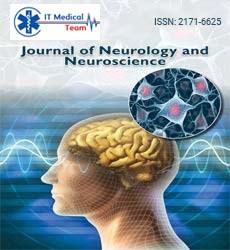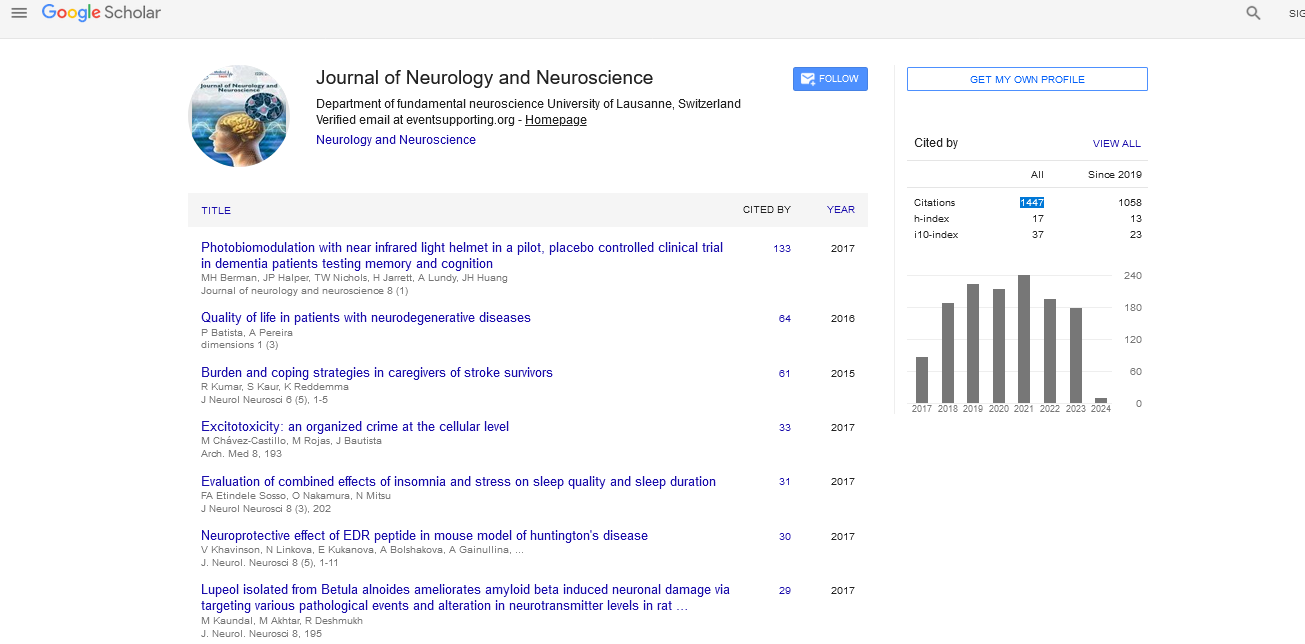Opinion - (2025) Volume 16, Issue 1
Harnessing the power of educational neuroscience and AI to improve learning efficacy
Gkintoni Huang*
Department of School of Health Sciences and Physiotherapy, University of Notre Dame Australia, 32 Mouat St, Fremantle, WA 6160, Australia
*Correspondence:
Gkintoni Huang, Department of School of Health Sciences and Physiotherapy, University of Notre Dame Australia, 32 Mouat St, Fremantle, WA 6160,
Australia,
Email:
Received: 30-Jan-2025, Manuscript No. ipjnn-25-15569;
Editor assigned: 01-Feb-2025, Pre QC No. P-15569;
Reviewed: 14-Feb-2025, QC No. Q-15569;
Revised: 20-Feb-2025, Manuscript No. R-15569;
Published:
27-Feb-2025
Introduction
The integration of educational neuroscience and
Artificial Intelligence (AI) has gained significant attention
as two transformative forces shaping the future of
education. Educational neuroscience explores how the
brain learns, while AI focuses on creating systems that
can mimic human intelligence. Together, these fields have
the potential to revolutionize how students learn, how
educators teach, and how learning environments are
designed. By harnessing the power of both neuroscience
and AI, we can create more personalized, effective, and
efficient learning experiences. This article will explore
the ways in which educational neuroscience and AI can
improve learning efficacy and highlight the promising
future they offer for education. Educational neuroscience,
also known as brain-based learning, is a field that
combines principles from neuroscience, psychology,
and education. It focuses on understanding how the
brain processes and retains information, and how this
knowledge can be applied to optimize learning outcomes.
For years, educators have relied on conventional teaching
methods without necessarily understanding the biological
mechanisms behind them. Educational neuroscience,
however, provides a deeper understanding of cognitive
processes such as attention, memory, and motivation—
processes that are crucial for learning [1].
Key discoveries in educational neuroscience include
insights into the brain’s plasticity, the way it adapts and
reorganizes itself in response to learning experiences.
This adaptability allows for more effective and targeted
teaching strategies. Additionally, neuroscience has
illuminated the importance of factors like sleep, physical
exercise, and emotional well-being in the learning process.
When these factors are optimized, they can significantly
enhance a student’s ability to learn. The implications
of educational neuroscience for teaching are vast. It
encourages educators to move away from one-size-fitsall
approaches and instead adopt methods that cater to
the diverse ways in which students’ brains process and
retain information. Neuroscience suggests that active
learning, spaced repetition, and techniques to enhance
focus and memory consolidation can improve retention
and understanding. Artificial intelligence, which refers
to systems capable of performing tasks that normally
require human intelligence (such as decision-making,
pattern recognition, and problem-solving), has made
its way into the field of education. AI technologies such
as machine learning, natural language processing, and
adaptive learning platforms have revolutionized how we
think about teaching and learning. These technologies
can analyze vast amounts of data, identify patterns,
and offer personalized learning experiences in ways that
were previously unimaginable. Furthermore, AI can assist educators by providing insights into student performance
and learning patterns. It can identify which students may
need additional support, offer feedback on assignments,
and even recommend targeted interventions. AI tools
can also streamline administrative tasks, freeing up time
for educators to focus more on teaching and less on
paperwork [2].
Description
While educational neuroscience and AI are
powerful on their own, their true potential lies in their
integration. When combined, these fields can provide an
unprecedented understanding of the learning process
and create more effective educational tools. Here are
several ways in which the synergy between neuroscience
and AI can improve learning efficacy. One of the most
promising applications of AI in education is the ability to
provide personalized learning. Drawing on insights from
neuroscience, AI systems can analyze individual learning
patterns and adapt content to fit each student’s cognitive
profile. For example, neuroscience research has shown
that different students may have varying working memory
capacities, attention spans, and processing speeds. AI can
use this information to create customized learning paths
that account for these differences. Moreover, AI-driven
tools can continuously adjust to a student’s evolving
needs. As they progress through the material, the system
can offer more challenging tasks, or provide additional
support when needed. This personalized approach leads
to higher engagement and more efficient learning, as
students receive content that is tailored to their individual
capabilities [3].
The ability to provide real-time feedback is another
area where the combination of neuroscience and AI
can greatly enhance learning efficacy. Neuroscience has
shown that immediate feedback helps reinforce learning
and improves retention. AI can facilitate this by offering
instant feedback on assignments, quizzes, or other
tasks, allowing students to understand their mistakes
and correct them before bad habits are formed. AI
systems can also adapt in real-time based on a student’s
responses. For example, if a student is struggling with
a particular concept, the AI can modify the lesson to
provide additional explanations or examples. Similarly,
if a student is excelling, the system can present more
advanced material, ensuring that they are continually
challenged. This dynamic adjustment promotes a deeper
understanding of the subject matter and keeps students
motivated to learn.
Cognitive engagement is critical for effective learning,
and both neuroscience and AI can play a role in enhancing
it. Neuroscience research has shown that emotions,
attention, and motivation are deeply intertwined with
cognitive processes. For students to be engaged in their
learning, they must feel emotionally connected to the
material and maintain their attention over extended
periods. AI technologies can create learning environments
that are more interactive and immersive, fostering greater
engagement. For example, AI-powered educational
games, simulations, and virtual reality experiences can
provide students with hands-on, experiential learning that
activates multiple brain regions. These types of activities
not only enhance cognitive engagement but also tap into
the brain's natural desire for novelty and challenge—key
components of motivation [4].
AI provides valuable data that can inform teaching
strategies and decisions. Drawing on neuroscience
principles, AI can offer insights into which teaching
methods are most effective for particular students.
For example, if a student is struggling with a concept,
AI might suggest specific teaching strategies that align
with how the brain processes information, such as
breaking the content into smaller, manageable chunks
or using multisensory techniques to reinforce learning.
Additionally, AI can help teachers monitor student
progress more efficiently. By analyzing data on individual
performance, AI can pinpoint which students need
additional support and what specific areas they are
struggling with. This allows teachers to intervene early
and provide targeted instruction, improving learning
outcomes.
The physical and emotional environment in which
learning occurs plays a significant role in student
outcomes. Neuroscience has demonstrated that factors
such as lighting, noise levels, and even the layout of
the classroom can impact cognitive performance. AI
can be used to optimize these factors to create the
ideal learning environment. For instance, AI-powered
classroom management systems can adjust lighting and
temperature based on students’ needs or even monitor
noise levels to ensure an environment conducive to
learning. Additionally, AI can assess the emotional climate
of a classroom, using facial recognition or sentiment
analysis to gauge students' moods. By understanding
emotional states, AI can suggest interventions to enhance
the learning atmosphere and support student well-being
[5].
As both educational neuroscience and AI continue
to evolve, their potential to improve learning efficacy
will only grow. Advances in brain-computer interfaces,
neurofeedback technologies, and AI algorithms will
enable even more personalized, dynamic, and effective
learning experiences. For example, future AI systems
may be able to predict students’ cognitive development
based on neural activity and tailor learning strategies
accordingly. Moreover, the ethical considerations
surrounding AI in education will need to be addressed.
Issues related to data privacy, equity, and bias must
be carefully considered to ensure that AI technologies
benefit all students, regardless of their background or
circumstances. As these challenges are addressed, the
collaboration between neuroscience and AI will continue
to shape a more inclusive and effective education system.
Conclusion
The integration of educational neuroscience and AI
holds immense promise for improving learning efficacy.
By combining insights into how the brain learns with
the power of AI to personalize and optimize learning
experiences, we can create more effective, engaging,
and tailored educational environments. The future
of education is one where neuroscience and AI work
together to help students reach their full potential,
unlocking new opportunities for learners and educators
alike. As these technologies continue to develop, we can
expect a more dynamic and transformative approach
to teaching and learning, one that is grounded in both
science and innovation.
References
- Yang W, Xiao Q, Zhang Y. HA R 2 bot: a human-centered augmented reality robot programming method with the awareness of cognitive load. J Intell Manuf 2024; 35(5):1985-2003.
Google Scholar, Crossref, Indexed at
- Castro-Alonso JC, de Koning BB, Fiorella L, et al. Five strategies for optimizing instructional materials: Instructor-and learner-managed cognitive load. Educ Psychol Rev 202; 33(4):1379-1407.
Google Scholar, Crossref, Indexed at
- Topping KJ, Trickey S. Collaborative philosophical enquiry for school children: Cognitive effects at 10–12 years. British Journal of Educational Psychology. 2007; 77(2):271-288.
Google Scholar, Crossref, Indexed at
- Ghanbari S, Haghani F, Barekatain M, et al. A systematized review of cognitive load theory in health sciences education and a perspective from cognitive neuroscience. J Educ Health Promot. 2020; 9(1):176.
Google Scholar, Crossref, Indexed at
- Gola G, Angioletti L, Cassioli F, et al. The teaching brain: Beyond the science of teaching and educational neuroscience. Front Psychol. 2022; 13:823832.
Google Scholar, Crossref, Indexed at





